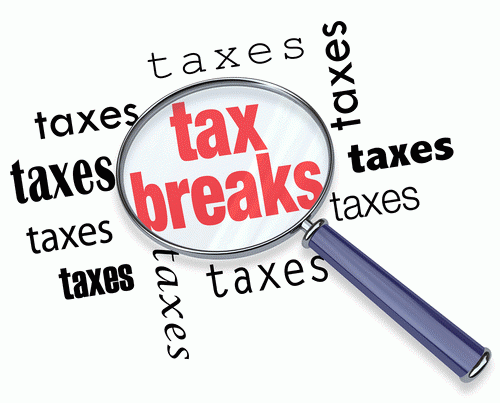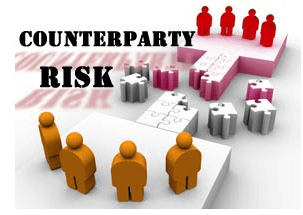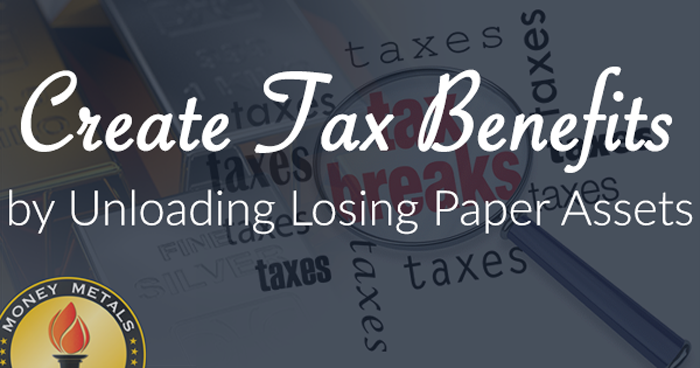Metals prices rallied a bit last week, but the fact is that spot prices are languishing near their four-year lows. There isn’t a whole lot to smile about, but there is an opportunity for tax-savvy investors to harvest some nice tax deductions for their capital losses while increasing and reinforcing their position in physical precious metals.
 Investors can accomplish another important goal at the same time: reducing counterparty risk. How?
Investors can accomplish another important goal at the same time: reducing counterparty risk. How?
By Selling Paper Investments that have Gone Down in Value and Buying Physical Metals Instead
Year-end is approaching, and the stock market may be entering a bear phase. Now may be a time to consider selling losing investments in equities, precious metals ETFs, metals futures contracts, or even mining shares and deducting the paper losses.
IRS rules allow singles and married people filing jointly to deduct up to $3,000 per year in capital losses (and more if you have other capital gains which can be offset). Losses above the limit can be carried forward to future years.
Investors can take the proceeds from the sale of these assets in their brokerage or futures accounts and simultaneously use them to buy bullion coins, rounds, or bars. They will avoid IRS wash-sale rules because physical bullion is not a “stock or security.” From the SEC.gov website:
Buy substantially identical stock or securities,
Acquire substantially identical stock or securities in a fully taxable trade, or
Acquire a contract or option to buy substantially identical stock or securities.
For more information about wash sales, read IRS Publication 550, Investment Income and Expenses (Including Capital Gains and Losses).
Selling security to harvest tax losses and then re-buying the same security requires the investor to wait 30 days between the sale and the purchase to avoid running afoul of wash sale rules. The sale of ETF shares or a futures contract to unlock valuable tax deductions would normally mean giving up a position in the metals for several weeks.
However, this other strategy does not require being out of your precious metals position at all -- now is a terrible time to give up your position and sit on the sidelines. You could simultaneously lock in your prices on purchases of the physical metal at the Money Metals Exchange and use the proceeds from your sales of the paper metals for payment. You could even increase your position by investing your expected tax savings into more ounces.
In this way, investors can maintain and even add to their metal's position and eliminate the counterparty risk inherent in all paper assets. For more on the counterparty and other risks associated with investing in precious metals-related ETFs, please click here.
 Volatility is once again rising in financial markets and counterparty risk must be considered. Most of the large banks and brokerages remain massively indebted and heavily exposed to derivatives and leverage. There is wisdom in reducing your chances of being caught in a bank failure or MF Global-type fraud by trading paper assets for zero counterparty risk bullion.
Volatility is once again rising in financial markets and counterparty risk must be considered. Most of the large banks and brokerages remain massively indebted and heavily exposed to derivatives and leverage. There is wisdom in reducing your chances of being caught in a bank failure or MF Global-type fraud by trading paper assets for zero counterparty risk bullion.
The swap that may produce the best returns of all is a trade of paper gold investments for physical silver bullion. With the gold-to-silver ratio over 70:1, silver currently appears extremely undervalued relative to gold (gold bar price). So investors with losses on their gold ETF or mining shares can lock in the tax advantages described above, reduce risk, and position themselves for silver to outperform -- all at the same time!
Readers should remember to consult their CPA or licensed securities professional for specific tax or investment advice. But if this maneuver makes sense for you, we’d like to help.
From now through the end of the year, Money Metals Exchange is offering free shipping on orders of at least $1,000 when customers take important (and money-saving) action to switch paper assets for any of our popular coins, rounds, or bars. So if you are buying metals from us after selling any form of paper metals, use the promo code “TAXES.” (We won’t ask you to provide confidential details related to the securities you plan to sell.)
Do exchange-traded products that track metals prices hold all the metal they claim, free and clear in physical form? There’s reason to believe they may not. Nevertheless, ETF buying represents demand from investors who seek exposure at least to the price fundamentals of physical precious metals, and the buying activity in the silver ETF has been especially brisk lately.
To avoid counter-party risks from ETF issuers and brokerage firms and to be certain you own the real thing, take actual possession of your physical precious metals. Or have them stored securely in your actual name – never “pooled” with other investors’ assets.
The upshot to these unexpectedly lower prices in the precious metals space is that more people will be able to accumulate more ounces. Buy low. Be patient. That’s how successful investors position themselves to be able to sell high down the road. Markets move in cycles. And just as surely as day follows night when the current bear phase in the money metals finally runs its course, a bull market will begin anew.

About the Author:
Clint Siegner is a Director at Money Metals Exchange, a precious metals dealer recently named "Best in the USA" by an independent global ratings group. A graduate of Linfield College in Oregon, Siegner puts his experience in business management along with his passion for personal liberty, limited government, and honest money into the development of Money Metals' brand and reach. This includes writing extensively on the bullion markets and their intersection with policy and world affairs.





